 Yellow-legged
Gull - Larus michahellis
Yellow-legged
Gull - Larus michahellis
(last update: October 08 2013)
Coordinators:
Delfín González
Gabriel Martín
Antonio Gutierrez
Amir Ben Dov
Mars Muusse
Larus michahellis - 2CY May
This website deals with the Yellow-legged Gull taxon michahellis, which is a common migrant from July to December in NW Europe. After extensive expansion of the breeding population during the last three decades, it nowadays can be found breeding in Belgium, the Netherlands and Britain in mixed couples with both Herring Gull (argenteus) and Lesser Black-backed Gull (graellsii). There are subtle differences between the populations from the Mediterranean, Atlantic coast of Portugal and Morocco and from the islands in the Atlantic. Most pronounced differences can be found in the taxon atlantis, now regarded as full species by some authors and birds along the Atlantic coast of the Iberian peninsular: lusitanius. Both atlantis and lusitanius are treated in their own sections on this website.
General description:
From mid-April onwards, 2CY michahellis start
dropping the inner primaries and the first wing-coverts. By May all 2CY michahellis are in active primary moult (except the odd individual). The wing-coverts which were included in the post-juvenile moult are normally left out of
the first stage of the complete moult in summer and are replaced in a later stage. The exact figures are hard to obtain, as birds
which do drop these earlier moulted feathers are not recognized of course
(unless birds are ringed and reported several times).
By May, the numbers of 2CY michahellis have increased at Etaples in NW France with a few 10's of birds in the
direct surrounding of the fish-market (about 75 on May 01 2003) and many immature birds using the
near landfill of Dannes to feed on.
The general appearance of 2CY michahellis is rather straightforward
in 95% of the birds. Strong and powerful males are easily recognized
between 2CY argenteus. Michahellis side-by-side argenteus can be viewed in this April picture. Examples of average May michahellis can be found in photo 03 and in photo
10. Those powerful birds (presumable males) show a combination of
(some) grey adult-like
scapulars, a pale head, contrasting with the neck-collar, dark-centred
tertials and often substantial numbers of wing-coverts replaced in the
first pre-basic (post-juvenile) moult and now, by May, active moult in the wing-coverts. Such features are indicative for michahellis and a combination of
these characteristics would be very odd for argenteus and argentatus,
by May.
Remember that our surveys took place in Etaples (location information on the Le
Portel Page), where you find michahellis from the western Mediterranean:
mainly from S
France, a few from Italy, Switzerland and NE Spain.
In most birds,
and especially when direct comparison is possible with argenteus, michahellis proofs to be ahead in moult. Nevertheless, michahellis moult
timing may show
overlap with argenteus from southernmost populations and local argenteus (argenteus breeds in the industrial area of Boulogne/Mer). Some Lesser Black-backed
Gulls graellsii and intermedius may resemble miniature michahellis,
as this taxon may show advanced moult in wing-coverts and tertials as
well. However, ID is often straightforward as its mainly the smaller taxon intermedius showing most advanced moult in LBBG. Furthermore, LBBG has a much broader
tail-band, darker inner primaries and the last required scapulars often
show much darker grey centres. Check out the 2CY May LBBG pages here and the first image on this page.
The third and tenth images represent strong male michahellis, easily recognized by the jizz, grey scapulars and often the replaced
wing-coverts. Some female michahellis may show very extensive grey
scapulars, as this bird demonstrates. Another distinct 'group' of 2CY michahellis can be recognized and
are represented by the bird in image 05.
These birds may be similar in jizz and size (thus probably males) and are
easily picked out of a group of argenteus Herring Gulls as well.
They do not show third generation grey adult-like scapulars but
have the third generation scapulars with barring or anchor patterning. The base colour is often brown-buffish in fresh feathers (by
May - June) and the pattern, which
can be bold and obvious, is normally repeated on the wing-coverts and
result in a complete barred plumage in freshly moulted birds (although
this completely replaced plumage can not be found in May birds but is
obtained by the end of June. See the June
Section for images).
Some michahellis may appear exceptionally advance
in moult, as the female in image 04 shows. Previous to the complete moult in summer, this individual has
replaced many wing-coverts, tertials and even all the rectrices.
Apparently, birds with advanced post-juvenile moult do not necessarily
develop all-grey scapulars in an early stage, and therefore, by the barred
patterns, do not look or appear more adult-like than others. We don't
know whether development of plain grey third generation scapulars or barred
third generation scapulars is gender related, but on average, it seems the
smaller birds (presumable females) develop more often grey scapulars than
barred.
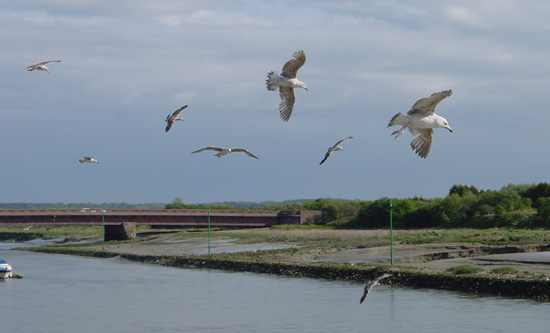
Low tide:
patrolling 2CY michahellis at the fish-market of Etaples,
NW France, early-May.
Moult stage and pace:
In the tables below, figures are presented on May moult scores in several feather tracts of 2CY michahellis. We described 60 2CY birds in detail on two visits at Etaples, Calais region.
By early May, primary moult is in progress with an average primary moult score of 3.5 by mid-May. Most advanced birds by mid-May show an obvious gap in the inner primaries, already missing P5 (almost 10% of the birds). Out of 43 birds, none had all primaries still in place and none had P1 still in place. This moult stage is matched by argenteus from this location with bulk of the present birds missing up to P3 or P4 (table below).
The majority (> 80%) of 2CY michahellis have all the rectrices still juvenile. A minor 13% started the moult of tail-feathers by mid-May. As can be seen in previous sections, low but substantial numbers of michahellis do replace rectrices from October to March.
In several sections of 1CY michahellis it's mentioned that birds include wing-coverts in the post-juvenile moult
(unlike argentatus / argenteus where this post-juvenile
moult is confined to the scapulars). To distinguish between 2CY birds
which have still suspended moult (after the post-juvenile moult) and birds
which have really started to replace wing-coverts, we separate between old
second generation feathers and fresh second generation feathers in the
table below. This is much easier said than done as the old second
generation feathers may have been required as early as late-August and
these wing-coverts may be extremely similar to the abraded juvenile
wing-coverts. Close views under excellent light conditions are necessary
to distinguish between the two by May.
Except the difference in timing of moult, these new second
generation feathers may show a different pattern as well, with fresh
second generation feathers moulted from April and May onwards looking 'less
immature': the base colour of the feathers is not buff-brown but
buff-grey or feathers may be "grey-based" and the pattern may be less well-defined.
Its interesting to see that the
wing-coverts
which were included in the post-juvenile moult are left out of the first
stage of the complete moult in early summer (until June at least) and are
replaced in a later stage. This is nicely demonstrated by a Swiss
metal-ringed michahellis Sempach 885629. The exact figures
of such moult sequences are hard to obtain, as birds
which do drop these earlier moulted feathers are not recognized of course.
The table below present figures of active wing-covert moult by mid-May. There still is a minority of birds showing fresh second generation wing-coverts: 25% of 2CY michahellis showing fresh median coverts. Active moult is most obvious in these median coverts and the lower lesser coverts (see Gull Topography for explanations of feather tracts). Over 80% of 2CY michahellis has at least shed some median coverts by mid-May and and are thus in active moult (the complete moult in 2CY, also called second basic moult of the summer months has started). Out of 39 birds, no birds have a complete juvenile wing-coverts panel, as delayed birds were showing (old) second generation wing-coverts as well.
Moult in the scapulars and mantle, moult to third generation scapulars, may start as early as mid-January in 2CY michahellis. By May, all present birds are showing active moult in the scapulars, but still, a majority of birds (60%) has less than 25% (optical measurement of visible area) of the scapulars renewed. Previous sections of 2CY michahellis show the most commonly seen moult sequence in the scapulars, starting with the lower upper scapulars and finishing with the rear lowest scapulars. So not surprisingly, its mainly the lower upper scapulars which have been replaced by May, as is illustrated by this bird. Nevertheless, some birds may appear very advanced in scapular moult, with most of the back adult-like grey (see e.g. this presumed female).
If close views can be obtained, many 2CY michahellis show a red or orangey-red orbital ring by May; see again this female and this female, but on the other hand also this male.
Tables:
| primary moult scores in 2CY Larus michahellis, Etaples, NW France. | |||||||||
| no miss | p1 miss | p2 miss | p3 miss | p4 miss | p5 miss | m: | n: | SD: | |
| 06 May 2001 | 1 | 2 | 4 | 6 | 4 | 2.6 | 17 | 1.18 | |
| 16 May 2002 | - | - | 4 | 19 | 16 | 4 | 3.5 | 43 | 0.80 |
| primary moult scores in 2CY Larus argentatus, Etaples, NW France. | |||||||||
| no miss | p1 miss | p2 miss | p3 miss | p4 miss | p5 miss | m: | n: | SD: | |
| 17 May 2002 | - | 2 | 8 | 36 | 27 | 2 | 3.3 | 75 | 0.79 |
rectrices moult scores in 2CY Larus michahellis, Etaples, NW France, May 16 2002. n = 43 |
|
| all juvenile | > 0 new rectrices |
| 38 | 5 |
| moult scores in several feather tracts of 2CY Larus michahellis, May 16 2002, Etaples, NW France. Total n = 44. Partial n fluctuates due to observation circumstances. | ||||||
| tertials | all juvenile | #1 missing | > 0 2nd generation | |||
| n = 39 | 7 | 23 | 9 | |||
| greater coverts | all juvenile | juvenile + old 2nd generation | > 0 missing | > 0 missing + new 2nd gen. | ||
| n = 40 | 12 | 16 | 8 | 4 | ||
| median coverts | < 5 missing + old 2nd generation | > 5 missing + old 2nd generation | < 5 missing + new 2nd generation | > 5 missing + new 2nd gen. | ||
| n = 39 | 7 | 22 | 3 | 7 | ||
| lower lesser coverts | < 5 missing | > 5 missing + < 5 new 2nd generation | > 5 new 2nd generation | |||
| n = 37 | 21 | 14 | 2 | |||
| lesser coverts | < 25% new 2nd gen. | 25% < new 2nd gen. < 50% | > 50% new 2nd gen. | |||
| n = 41 | 33 | 6 | 2 | |||
| scapulars | < 25% 3rd gen. | 25% < 3rd gen. < 50% | 50% < 3rd gen. < 75% | 75% < 3rd gen. < 100% | ||
| n = 38 | 22 | 4 | 3 | 9 | ||
 Yellow-legged
Gull michahellis 2CY 071Z May 01-02 2003, Etaples - Boulogne/Mer, France.
Yellow-legged
Gull michahellis 2CY 071Z May 01-02 2003, Etaples - Boulogne/Mer, France. Yellow-legged
Gull michahellis 2CY 965X May 01-02 2003, Etaples - Boulogne/Mer, France.
Yellow-legged
Gull michahellis 2CY 965X May 01-02 2003, Etaples - Boulogne/Mer, France. Yellow-legged
Gull michahellis 2CY Sempach
895110 May 01-02 2003, Etaples, NW
France. Present from autumn 2002 onwards.
Yellow-legged
Gull michahellis 2CY Sempach
895110 May 01-02 2003, Etaples, NW
France. Present from autumn 2002 onwards. AE4F8694 Tel Aviv University Zoological Garden 30.5.11.jpg) Yellow-legged
Gull michahellis 2CY U1KF May 30 2011, Tel Aviv University - Zool. Garden, Israel. Picture: Amir Ben Dov.
Yellow-legged
Gull michahellis 2CY U1KF May 30 2011, Tel Aviv University - Zool. Garden, Israel. Picture: Amir Ben Dov.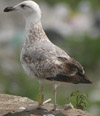 Yellow-legged Gull michahellis 2CY S1NV May 17 2007, Lubna, Warsaw, Poland (52.02 N 21.08 E). Picture: Ruud Altenburg.
Yellow-legged Gull michahellis 2CY S1NV May 17 2007, Lubna, Warsaw, Poland (52.02 N 21.08 E). Picture: Ruud Altenburg. Yellow-legged Gull michahellis 2CY S1PM May 17 2007, Lubna, Warsaw, Poland (52.02 N 21.08 E). Picture: Ruud Altenburg.
Yellow-legged Gull michahellis 2CY S1PM May 17 2007, Lubna, Warsaw, Poland (52.02 N 21.08 E). Picture: Ruud Altenburg. Yellow-legged
Gull michahellis 2CY, May 23 2012, Sant Carles de la Rapita - Ebro Delta, Cataluna, Spain. Picture: Chris Gibbins.
Yellow-legged
Gull michahellis 2CY, May 23 2012, Sant Carles de la Rapita - Ebro Delta, Cataluna, Spain. Picture: Chris Gibbins. Yellow-legged
Gull michahellis 2CY, May 23 2012, Sant Carles de la Rapita - Ebro Delta, Cataluna, Spain. Picture: Chris Gibbins.
Yellow-legged
Gull michahellis 2CY, May 23 2012, Sant Carles de la Rapita - Ebro Delta, Cataluna, Spain. Picture: Chris Gibbins.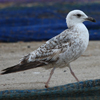 Yellow-legged
Gull michahellis 2CY, May 23 2012, Sant Carles de la Rapita - Ebro Delta, Cataluna, Spain. Picture: Chris Gibbins.
Yellow-legged
Gull michahellis 2CY, May 23 2012, Sant Carles de la Rapita - Ebro Delta, Cataluna, Spain. Picture: Chris Gibbins. Yellow-legged
Gull michahellis 2CY, May 23 2012, Sant Carles de la Rapita - Ebro Delta, Cataluna, Spain. Picture: Chris Gibbins.
Yellow-legged
Gull michahellis 2CY, May 23 2012, Sant Carles de la Rapita - Ebro Delta, Cataluna, Spain. Picture: Chris Gibbins. Yellow-legged
Gull michahellis 2CY, May 23 2012, Sant Carles de la Rapita - Ebro Delta, Cataluna, Spain. Picture: Chris Gibbins.
Yellow-legged
Gull michahellis 2CY, May 23 2012, Sant Carles de la Rapita - Ebro Delta, Cataluna, Spain. Picture: Chris Gibbins. Yellow-legged
Gull michahellis 2CY, May 23 2012, Sant Carles de la Rapita - Ebro Delta, Cataluna, Spain. Picture: Chris Gibbins.
Yellow-legged
Gull michahellis 2CY, May 23 2012, Sant Carles de la Rapita - Ebro Delta, Cataluna, Spain. Picture: Chris Gibbins. Yellow-legged
Gull michahellis 2CY, May 23 2012, Sant Carles de la Rapita - Ebro Delta, Cataluna, Spain. Picture: Chris Gibbins.
Yellow-legged
Gull michahellis 2CY, May 23 2012, Sant Carles de la Rapita - Ebro Delta, Cataluna, Spain. Picture: Chris Gibbins.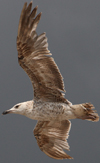 Yellow-legged
Gull michahellis 2CY, May 23 2012, Sant Carles de la Rapita - Ebro Delta, Cataluna, Spain. Picture: Chris Gibbins.
Yellow-legged
Gull michahellis 2CY, May 23 2012, Sant Carles de la Rapita - Ebro Delta, Cataluna, Spain. Picture: Chris Gibbins. Yellow-legged
Gull michahellis 2CY, May 23 2012, Sant Carles de la Rapita - Ebro Delta, Cataluna, Spain. Picture: Chris Gibbins.
Yellow-legged
Gull michahellis 2CY, May 23 2012, Sant Carles de la Rapita - Ebro Delta, Cataluna, Spain. Picture: Chris Gibbins. Yellow-legged Gull michahellis 2CY, May 26 2007, Portalban, Switzerland. Picture: Stephane Aubry.
Yellow-legged Gull michahellis 2CY, May 26 2007, Portalban, Switzerland. Picture: Stephane Aubry.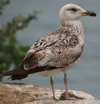 Yellow-legged Gull michahellis 2CY, May 26 2007, Portalban, Switzerland. Picture: Stephane Aubry.
Yellow-legged Gull michahellis 2CY, May 26 2007, Portalban, Switzerland. Picture: Stephane Aubry. Yellow-legged
Gull michahellis 2CY, May 02 2003, Etaples, NW France. Two
flying birds.
Yellow-legged
Gull michahellis 2CY, May 02 2003, Etaples, NW France. Two
flying birds. Yellow-legged
Gull michahellis 2CY, May 04 2001, Le Portel France. Probably a male.
Yellow-legged
Gull michahellis 2CY, May 04 2001, Le Portel France. Probably a male.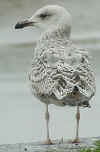 Yellow-legged
Gull michahellis 2CY, May 04 2001, Etaples France.
Yellow-legged
Gull michahellis 2CY, May 04 2001, Etaples France. Yellow-legged
Gull michahellis 2CY, May 04 2001, Etaples France. With a few third generation grey scapulars.
Probably a male.
Yellow-legged
Gull michahellis 2CY, May 04 2001, Etaples France. With a few third generation grey scapulars.
Probably a male. Yellow-legged
Gull michahellis 2CY, May 17 2002, Boulogne/Mer France. With a few third generation grey scapulars.
Probably a male.
Yellow-legged
Gull michahellis 2CY, May 17 2002, Boulogne/Mer France. With a few third generation grey scapulars.
Probably a male. Yellow-legged
Gull michahellis 2CY, May 04 2001, Etaples France. Probably a female.
Yellow-legged
Gull michahellis 2CY, May 04 2001, Etaples France. Probably a female. Yellow-legged
Gull michahellis 2CY, May 04 2001 Etaples France. An example of a michahellis that has all the
coverts still juvenile, and in this respect resembles the bulk of argenteus in Western-Europe.
Yellow-legged
Gull michahellis 2CY, May 04 2001 Etaples France. An example of a michahellis that has all the
coverts still juvenile, and in this respect resembles the bulk of argenteus in Western-Europe. Yellow-legged
Gull michahellis 2CY, May 04 2001, Etaples France. Female, with
95% of the scapulars grey.
Yellow-legged
Gull michahellis 2CY, May 04 2001, Etaples France. Female, with
95% of the scapulars grey. Yellow-legged
Gull michahellis 2CY, May 04 2001 Etaples France. With
replaced median and inner lesser
coverts.
Yellow-legged
Gull michahellis 2CY, May 04 2001 Etaples France. With
replaced median and inner lesser
coverts. Yellow-legged
Gull michahellis 2CY, May 06 2001, Dannes - Le Portel France. In jizz, especially head
profile, much like intermedius.
Yellow-legged
Gull michahellis 2CY, May 06 2001, Dannes - Le Portel France. In jizz, especially head
profile, much like intermedius.